Robert Bosch GmbH Bundle
Decoding the Global Powerhouse: How Does Robert Bosch GmbH Thrive?
Robert Bosch GmbH, a titan of engineering and technology, boasts a significant global footprint and a remarkable ability to adapt. In 2024, the Robert Bosch GmbH SWOT Analysis revealed its impressive financial performance, with preliminary sales reaching 90.5 billion euros. But how does this sprawling enterprise, with its diverse portfolio from automotive components to power tools, actually function and maintain its competitive edge?
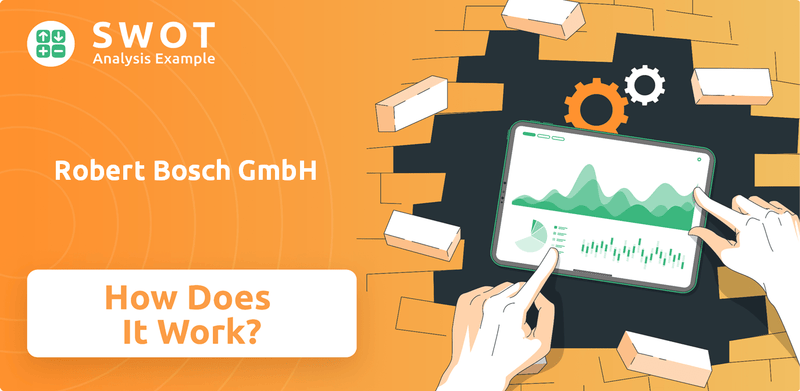
Understanding the intricacies of Bosch operations is key for anyone seeking to navigate the complexities of the global market. This analysis will explore the Bosch business model, its revenue streams, and its strategic responses to industry shifts. We will examine how the Bosch company structure supports its innovation and its impact on the automotive industry and beyond, revealing the secrets behind its enduring success and its commitment to sustainable solutions.
What Are the Key Operations Driving Robert Bosch GmbH’s Success?
Robert Bosch GmbH, a global leader in technology and services, operates across four primary business sectors, delivering value through diverse products and solutions. The company's core operations are built on a foundation of manufacturing, technology development, and a robust global supply chain. This integrated approach allows the company to offer cross-domain solutions and maintain a competitive edge in the market.
The company's value proposition centers on innovation, quality, and sustainability, with a strong focus on contributing to a better future. Bosch's commitment to research and development, coupled with its global presence and extensive partnerships, enables it to meet the evolving needs of its customers and address global challenges. The company's business model is designed to create long-term value for its stakeholders.
Bosch's operations are characterized by a commitment to sustainability and innovation, as well as a strong global presence. The company's focus on these areas allows it to maintain a competitive edge in the market and create long-term value for its stakeholders. To understand how Bosch navigates its competitive environment, consider the Competitors Landscape of Robert Bosch GmbH.
The Mobility Solutions sector provides a wide range of automotive components and solutions. This includes powertrain technologies, advanced driver-assistance systems, and software-defined vehicle solutions. In 2024, this sector generated sales revenue of 55.9 billion euros, demonstrating its significant contribution to the company's overall performance.
Bosch Rexroth offers drive and control technologies, while Bosch Manufacturing Solutions provides process and packaging technology. The Industrial Technology sector recorded sales revenue of 6.5 billion euros in 2024. This sector focuses on technologies for factory automation and mobile machinery.
This sector includes power tools and household appliances. Sales revenue in this sector reached 20.3 billion euros in 2024. Bosch is expanding its cordless power tool line, with approximately 90 new launches planned in 2025, and is adopting the Matter connectivity standard for smart appliances.
This sector focuses on systems for air conditioning, hot water, decentralized energy management, and security systems. It generated 7.5 billion euros in sales revenue in 2024. This sector contributes to sustainable and energy-efficient solutions for buildings.
Bosch operates approximately 225 manufacturing plants worldwide and collaborates with over 35,000 suppliers in about 60 countries. A 'local-for-local' approach is used to shorten supply chains and enhance resilience. The company invests heavily in research and development, with 85,500 associates across 136 locations, including 44,000 software engineers.
- Extensive R&D network drives innovation.
- Focus on software and AI for cross-domain solutions.
- Emphasis on flexible manufacturing processes.
- Commitment to sustainability and innovation.
Robert Bosch GmbH SWOT Analysis
- Complete SWOT Breakdown
- Fully Customizable
- Editable in Excel & Word
- Professional Formatting
- Investor-Ready Format
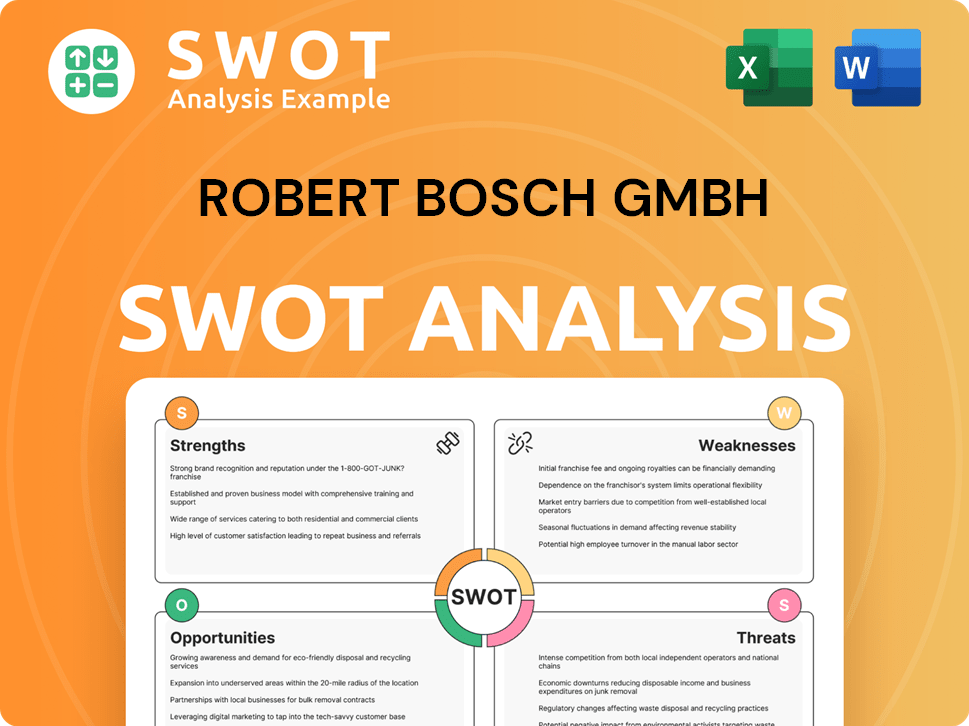
How Does Robert Bosch GmbH Make Money?
The Robert Bosch GmbH's revenue streams are diversified across four main business sectors: Mobility Solutions, Industrial Technology, Consumer Goods, and Energy and Building Technology. This structure supports a robust business model, enabling the company to navigate market fluctuations effectively. The company's ability to generate revenue is closely tied to its diverse portfolio and strategic investments.
In 2024, the preliminary sales revenue reached 90.5 billion euros, showcasing the scale of Bosch operations. The Mobility Solutions sector was the largest contributor, indicating the significance of the automotive industry for the company. The Consumer Goods sector also showed growth, demonstrating the company's resilience and ability to adapt to consumer demand.
Beyond product sales, Bosch is increasingly focused on software and services for monetization. The company anticipates substantial revenue from these areas by 2030, with a significant portion expected from the Mobility business area. This strategic shift towards software and digital services highlights Bosch's efforts to stay competitive in a rapidly evolving market.
The Bosch business model relies on a diverse range of products and services, coupled with strategic investments and expansions. The company's financial performance is a result of its diversified approach and its ability to adapt to changing market dynamics. For more insights into Bosch's growth strategy, consider reading the Growth Strategy of Robert Bosch GmbH.
- Mobility Solutions: This sector generated 55.9 billion euros in sales revenue in 2024, highlighting its dominance.
- Consumer Goods: Recorded 20.3 billion euros in sales revenue, with a 2% nominal growth, signaling a return to growth.
- Industrial Technology: Contributed 6.5 billion euros in sales revenue.
- Energy and Building Technology: Achieved 7.5 billion euros in sales revenue.
- Software and Services: Anticipates billions in sales by 2030, with a significant portion from Mobility.
- Strategic Acquisitions and Investments: The planned acquisition of Johnson Controls and Hitachi's HVAC business, worth around 8 billion U.S. dollars, strengthens its presence in high-growth markets.
Robert Bosch GmbH PESTLE Analysis
- Covers All 6 PESTLE Categories
- No Research Needed – Save Hours of Work
- Built by Experts, Trusted by Consultants
- Instant Download, Ready to Use
- 100% Editable, Fully Customizable
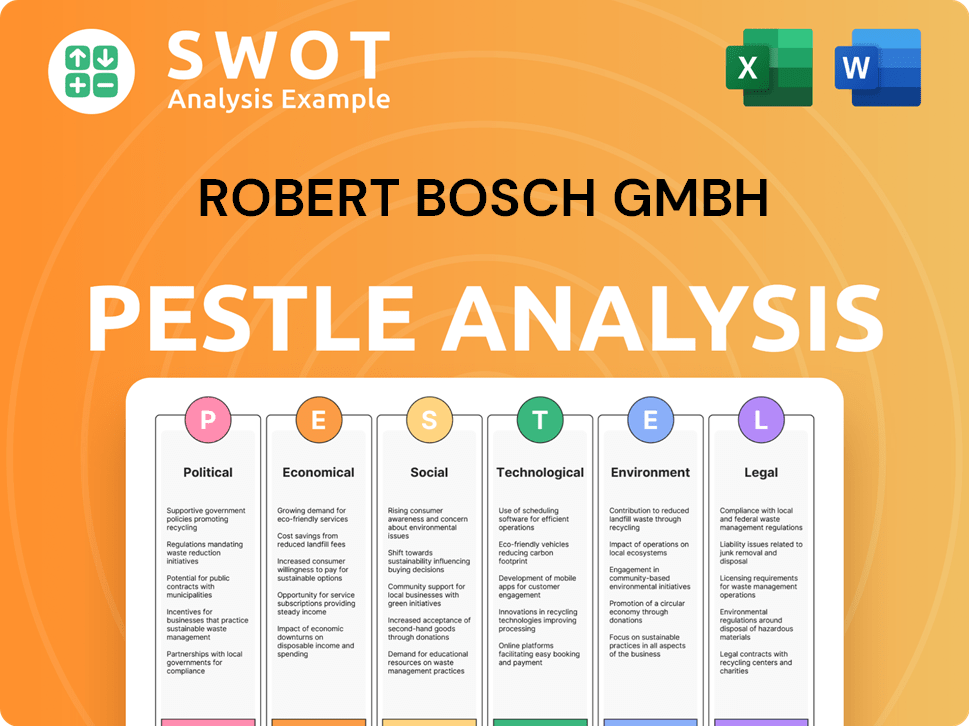
Which Strategic Decisions Have Shaped Robert Bosch GmbH’s Business Model?
In 2024, Robert Bosch GmbH faced a challenging economic climate, yet demonstrated resilience. The company reported a slight nominal sales revenue decrease of 1% to 90.5 billion euros. This performance reflects the complexities of the current market environment, including shifts in the automotive industry and global economic uncertainties. Despite these hurdles, Bosch continues to implement strategic initiatives to maintain its competitive edge and drive future growth.
A significant strategic move in 2024 was the announcement of the acquisition of Johnson Controls and Hitachi's HVAC business. This acquisition, valued at approximately 8 billion U.S. dollars, is aimed at expanding Bosch's presence in growth markets such as the U.S. and Asia. This move underscores Bosch's commitment to diversifying its portfolio and capitalizing on opportunities in emerging sectors. The deal is expected to close in 2025, further solidifying Bosch's market position.
The company also made structural adjustments and divestments in 2024 to enhance competitiveness, including divesting portions of its Building Technologies division's security and communication product businesses. These actions are part of a broader strategy to streamline operations and focus resources on core competencies and high-growth areas. These efforts are crucial for the long-term success of the Bosch company.
Bosch's history includes significant milestones, such as the development of innovative automotive technologies and the expansion into diverse business sectors. The company's commitment to innovation has led to numerous patents and technological advancements. Growth Strategy of Robert Bosch GmbH highlights the company's strategic approach to navigating market changes and achieving sustainable growth.
Strategic moves include acquisitions, divestitures, and partnerships aimed at strengthening market position and expanding into new areas. The acquisition of Johnson Controls and Hitachi's HVAC business is a prime example of Bosch's proactive approach to growth. The company also focuses on internal restructuring to improve efficiency and focus on core competencies.
Bosch's competitive edge is based on technological leadership, a diversified business portfolio, and a global presence. Substantial R&D investments, amounting to 7.8 billion euros in 2024, fuel innovation and patent filings. The company's global footprint and 'local-for-local' supply chain strategy contribute to its resilience.
Looking ahead, Bosch is focused on AI implementation and e-mobility projects. The company is investing in new venture capital for startups. Bosch is also committed to its Strategy 2030, aiming for an annual growth rate of 6-8% and a minimum EBIT margin of 7% by 2026.
Bosch's competitive advantages are rooted in its technological prowess, diversified business model, and global reach. The company's significant R&D investments and patent filings underscore its commitment to innovation. Bosch's system design knowledge and in-house semiconductor manufacturing capabilities further strengthen its position in the market.
- Technological Leadership: R&D investments of 7.8 billion euros in 2024, leading to over 6,700 patents filed.
- Diversified Business Portfolio: Spanning mobility, industrial technology, consumer goods, and energy and building technology, mitigating sector-specific risks.
- Global Footprint: Operations in over 60 countries, with a 'local-for-local' supply chain strategy.
- Strategic Partnerships: Collaborations with Microsoft for generative AI development and joint ventures for semiconductor manufacturing.
Robert Bosch GmbH Business Model Canvas
- Complete 9-Block Business Model Canvas
- Effortlessly Communicate Your Business Strategy
- Investor-Ready BMC Format
- 100% Editable and Customizable
- Clear and Structured Layout
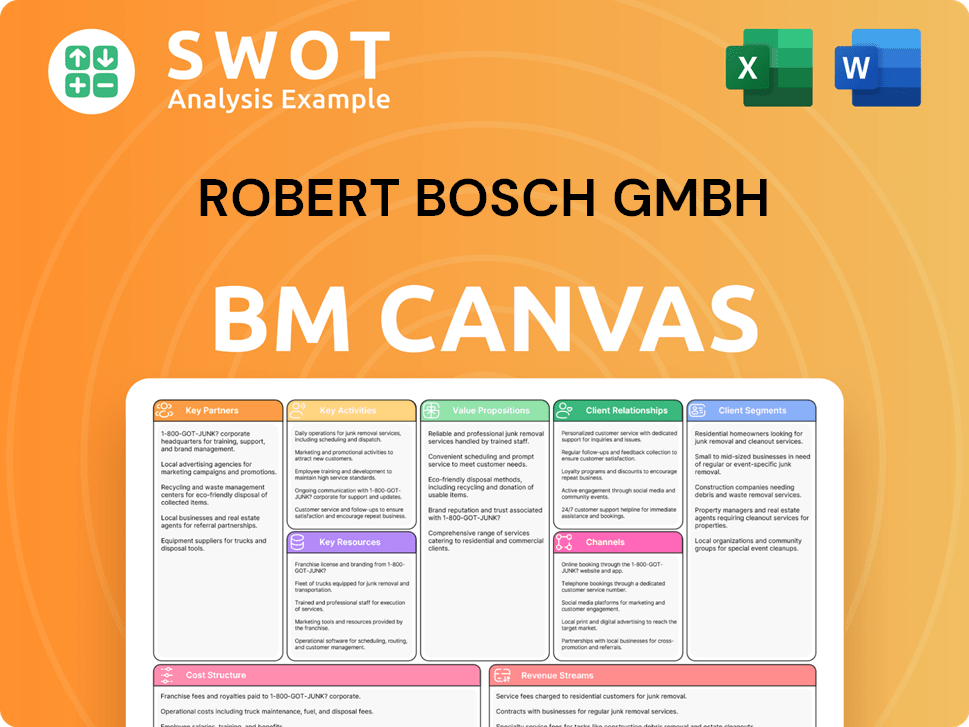
How Is Robert Bosch GmbH Positioning Itself for Continued Success?
The Bosch company maintains a strong industry position across various sectors. In the automotive industry, Robert Bosch GmbH is recognized as the largest automotive supplier globally. Beyond automotive, the company has a presence in building automation and control systems, holding a 2.29% market share in 2024. With a global presence, Bosch operations extend to over 60 countries, employing approximately 417,900 associates worldwide as of December 31, 2024.
However, Bosch faces several risks. These include challenges from the global economy, slower growth in electromobility, and increasing competition, particularly from Asia. The company must also manage costs and structural adjustments, including potential job reductions, to remain competitive. Regulatory changes and technological disruptions also pose ongoing challenges. To learn more about the company's origins, you can read the Brief History of Robert Bosch GmbH.
As a leading automotive supplier, Bosch holds a significant market share. The company's diverse portfolio includes automotive technology, industrial technology, consumer goods, and energy and building technology. Bosch's global presence and wide range of Bosch products contribute to its strong industry standing.
Key risks include global economic weakness, slower electromobility development, and intense competition. Bosch also faces pressure to manage costs and adapt to changing markets. Regulatory changes and technological disruptions continually challenge the company's operations.
The company is focused on profitable growth and aims for a 7% EBIT margin by 2026. Bosch invests heavily in future technologies, with around 13 billion euros in upfront investments in 2024. This includes AI, software-defined vehicles, hydrogen technology, and sustainable solutions.
Key initiatives include the Strategy 2030, aiming to be a top-three provider in core markets. Bosch is expanding its global production network to boost supply chain resilience. In Q1 2025, the company increased its sales revenue by 4%, showing early positive signs.
Bosch is heavily investing in future technologies to maintain its competitive edge. The company is focusing on innovation in areas such as artificial intelligence (AI) and software-defined vehicles (SDV).
- Hydrogen Technology: Plans to launch its first electrolysis stack for hydrogen production in 2025.
- Sustainable Solutions: Investing in environmentally friendly technologies.
- Global Production Network: Expanding its network to enhance supply chain resilience.
- Financial Performance: Increased sales revenue by 4% in the first quarter of 2025.
Robert Bosch GmbH Porter's Five Forces Analysis
- Covers All 5 Competitive Forces in Detail
- Structured for Consultants, Students, and Founders
- 100% Editable in Microsoft Word & Excel
- Instant Digital Download – Use Immediately
- Compatible with Mac & PC – Fully Unlocked
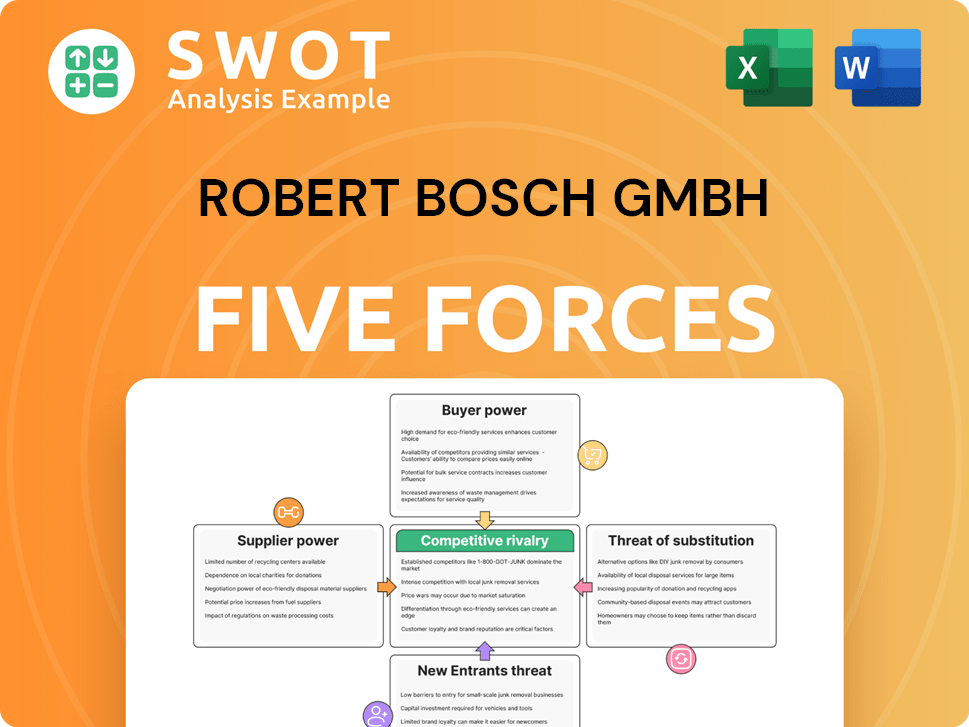
Related Blogs
- What are Mission Vision & Core Values of Robert Bosch GmbH Company?
- What is Competitive Landscape of Robert Bosch GmbH Company?
- What is Growth Strategy and Future Prospects of Robert Bosch GmbH Company?
- What is Sales and Marketing Strategy of Robert Bosch GmbH Company?
- What is Brief History of Robert Bosch GmbH Company?
- Who Owns Robert Bosch GmbH Company?
- What is Customer Demographics and Target Market of Robert Bosch GmbH Company?
Disclaimer
All information, articles, and product details provided on this website are for general informational and educational purposes only. We do not claim any ownership over, nor do we intend to infringe upon, any trademarks, copyrights, logos, brand names, or other intellectual property mentioned or depicted on this site. Such intellectual property remains the property of its respective owners, and any references here are made solely for identification or informational purposes, without implying any affiliation, endorsement, or partnership.
We make no representations or warranties, express or implied, regarding the accuracy, completeness, or suitability of any content or products presented. Nothing on this website should be construed as legal, tax, investment, financial, medical, or other professional advice. In addition, no part of this site—including articles or product references—constitutes a solicitation, recommendation, endorsement, advertisement, or offer to buy or sell any securities, franchises, or other financial instruments, particularly in jurisdictions where such activity would be unlawful.
All content is of a general nature and may not address the specific circumstances of any individual or entity. It is not a substitute for professional advice or services. Any actions you take based on the information provided here are strictly at your own risk. You accept full responsibility for any decisions or outcomes arising from your use of this website and agree to release us from any liability in connection with your use of, or reliance upon, the content or products found herein.